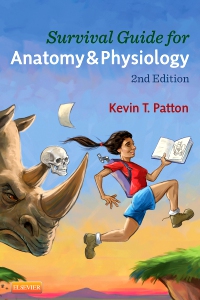
Survival Guide for Anatomy & Physiology, 2nd Edition
Paperback

How many of your students are overwhelmed by the perils and pitfalls of learning A&P? Survival Guide for Anatomy & Physiology, 2nd Edition provides a quick and easy overview of tips and strategies to make studying more productive, more fun, and less time-consuming. A perfect on-the-go reference, this handy guide is packed with colorful cartoons, labeled A&P visuals, illustrated tables, and keen insights to help students prepare for even the most dangerous labs and exams. Joining this excellent adventure are two new survival skill chapters plus strategies for using digital resources effectively. Written by renowned A&P educator and author Kevin Patton, this book makes it easier for your students to survive and conquer this difficult subject.
-
- NEW! Know the Language chapter focuses on strategies for mastering medical terminology.
- UPDATED information includes more on digital-based learning strategies, more examples, and additional study tips to help students develop skills in mastering pronunciation, dealing with test anxiety, using flashcards, and more.
- Mnemonic devices and memorable analogies help students remember A&P concepts with ease.
- NEW! What to Do If You Get Lost chapter offers advice on getting back on track from Kevin Patton, whose enthusiasm, humor, and special insights have guided many students through the A&P wilderness.
- New cartoons and illustrated tables simplify facts and concepts relating to topics such as tissues, joint movements, regions of the brain, and more.
- New analogies and tips make deeper connections between challenging A&P concepts and the real world, including What’s a Gradient?, Bone Names Have Meaning, Mnemonics to Help You Learn Bone Structures, and more.
- Dozens of tables make it easy for students to access key A&P facts on the skeletal system, muscles, nerves, circulatory, respiratory, and digestive systems, and more.
- Specific test-taking strategies help students prepare for and pass exams.
- New appendices on common abbreviations and word parts make it easy to look up prefixes, suffixes, abbreviations, and more.
-
- NEW! Know the Language chapter focuses on strategies for mastering medical terminology.
- UPDATED information includes more on digital-based learning strategies, more examples, and additional study tips to develop skills in mastering pronunciation, dealing with test anxiety, using flashcards, and more.
- New analogies and tips help you make deeper connections between challenging A&P concepts and the real world, including What’s a Gradient?, Bone Names Have Meaning, Mnemonics to Help You Learn Bone Structures, and more.
- NEW! What to Do If You Get Lost chapter offers advice on getting back on track from Kevin Patton, whose enthusiasm, humor, and special insights have guided many students through the A&P wilderness.
- New cartoons and illustrated tables simplify facts and concepts relating to topics such as tissues, joint movements, regions of the brain, and more.
- New appendices on common abbreviations and word parts make it easy to look up prefixes, suffixes, abbreviations, and more.
-
PART 1: Introduction to the Survival Skills
Survival Skill 1: Have a Winning Attitude
Survival Skill 2: Know Your Learning Style
Survival Skill 3: Know the Language
Survival Skill 4: Plan a Learning Strategy
Survival Skill 5: Arrange a Suitable Study Area
Survival Skill 6: Plan a Reading Strategy
Survival Skill 7: Analyze Your Note-Taking Skills
Survival Skill 8: Study Actively
Survival Skill 9: Use All Your Resources
Survival Skill 10: Prepare for Tests
Survival Skill 11: Use Test-Taking Strategies During and After a Test
Survival Skill 12: What To Do If You Get Lost
Special Survival Skills
- Learners with Special Needs
- Pronunciation
- Time Management Tools
- Returning Learners
- Using Flash Cards Effectively
- Using Your Digital Device to Study A&P
- Test Anxiety
- Climbing the Learning Pyramid
- English as a Second Language
- The Student Laboratory
PART 2: Maps, Charts, & Shortcuts, Special Survival Skills: Using Models and Analogies
1. The Body as a Whole
2. Support and Movement
3. Communication, Control, and Integration
4. Transportation and Defense
5. Respiration, Nutrition, and Excretion
6. Reproduction and Development
Common Word Parts
Common Abbreviations

 as described in our
as described in our 